|
Click any typewriter

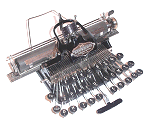
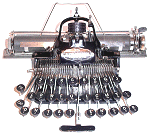
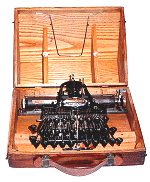
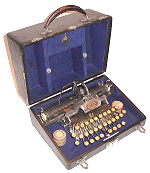
Blick Featherweight 1910
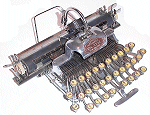
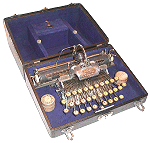
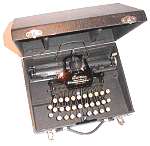
Rem-Blick 1928
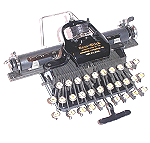
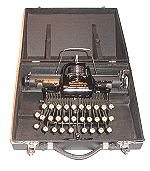
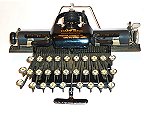
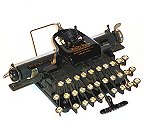


|
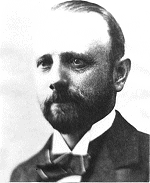 The
title of first true portable typewriter belongs to the machines designed and
built by George C Blickensderfer (1850-1917), a brilliantly original American engineer.
But, ironically, it was not a portable typewriter that he set out to make.
Rather, Blickensderfer set out to make a desk machine to rival Remington’s
desk models. The resulting Blickensderfer 1 was a revolutionary design, with far fewer
parts and hence much smaller and lighter, but unfortunately no examples of this
first machine have survived. His typewriter used a rotating typewheel that could
be quickly replaced to change typefaces, anticipating the IBM ‘Golf Ball’ by
half a century. This design also enabled the typist to see the typed work at a
time when most typewriters were understrike machines that concealed the writing.
When Blickensderfer unveiled his Model 1 at the Chicago World’s Fair of 1893,
these revolutionary features attracted huge crowds and a full order-book –
many of them from Britain, Germany and The
title of first true portable typewriter belongs to the machines designed and
built by George C Blickensderfer (1850-1917), a brilliantly original American engineer.
But, ironically, it was not a portable typewriter that he set out to make.
Rather, Blickensderfer set out to make a desk machine to rival Remington’s
desk models. The resulting Blickensderfer 1 was a revolutionary design, with far fewer
parts and hence much smaller and lighter, but unfortunately no examples of this
first machine have survived. His typewriter used a rotating typewheel that could
be quickly replaced to change typefaces, anticipating the IBM ‘Golf Ball’ by
half a century. This design also enabled the typist to see the typed work at a
time when most typewriters were understrike machines that concealed the writing.
When Blickensderfer unveiled his Model 1 at the Chicago World’s Fair of 1893,
these revolutionary features attracted huge crowds and a full order-book –
many of them from Britain, Germany and 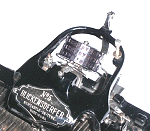 France whose business machine markets
were more highly developed than the US. However, at the same Exhibition he also
showed a stripped down version of the machine, called the Model 5, intended to
be a cheap version for customers with low budgets. In
the event, it was this low-budget version that caught public imagination and
the machine that the Blickensderfer factory in Stamford, Connecticut, turned out
in the tens of thousands between 1895 and 1917. It was
Blickensderfer's genius as a mechanical designer that enabled this lightness and
simplicity. His design is completely outside the mainstream -- almost
shocking in its simplicity. Whereas a Remington or Underwood desk machine
contained around 2,500 parts, Blickensderfer's machine contains only around
250. Hence he was able to sell it for the incredibly low price of
$35. Blickensderfer’s machines also had an innovatory keyboard layout.
France whose business machine markets
were more highly developed than the US. However, at the same Exhibition he also
showed a stripped down version of the machine, called the Model 5, intended to
be a cheap version for customers with low budgets. In
the event, it was this low-budget version that caught public imagination and
the machine that the Blickensderfer factory in Stamford, Connecticut, turned out
in the tens of thousands between 1895 and 1917. It was
Blickensderfer's genius as a mechanical designer that enabled this lightness and
simplicity. His design is completely outside the mainstream -- almost
shocking in its simplicity. Whereas a Remington or Underwood desk machine
contained around 2,500 parts, Blickensderfer's machine contains only around
250. Hence he was able to sell it for the incredibly low price of
$35. Blickensderfer’s machines also had an innovatory keyboard layout.
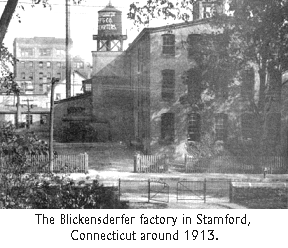 He
placed the most commonly used letters DHIATENSOR along the first row of keys,
claiming this to be a more scientifically efficient layout, and made QWERTY
keyboards available only by special order. In 1909, the company started to
produce the Number 5 machine in aluminium and the following year
produced the Blick Featherweight with a fold-away ink frame. This
machine, famously described in ads as 'The Five pound Secretary' is
almost certainly the lightest portable typewriter ever produced. Sales companies were opened in England,
France and Germany, and for the first few years of the new century production
rose. However, the advantages of
Blickensderfer’s design were temporary. Underwood and then Remington launched
‘visible writing’ machines. The new Royal company introduced its compact,
visible machine in 1906. From 1908, when the first Standard Folding portable was
launched, Blickensderfer sales started to fall off. The final blow fell in 1914
with the outbreak of war. Whereas the rival Corona company received orders
totalling 30,000 machines from the US, British and French armies, Blickensderfer
received no war orders and found its European markets cut off by the conflict.
Blickensderfer attempted to diversify, including manufacturing a typebar machine
designed by Lyman Roberts, under license, as the Blick 90. He
placed the most commonly used letters DHIATENSOR along the first row of keys,
claiming this to be a more scientifically efficient layout, and made QWERTY
keyboards available only by special order. In 1909, the company started to
produce the Number 5 machine in aluminium and the following year
produced the Blick Featherweight with a fold-away ink frame. This
machine, famously described in ads as 'The Five pound Secretary' is
almost certainly the lightest portable typewriter ever produced. Sales companies were opened in England,
France and Germany, and for the first few years of the new century production
rose. However, the advantages of
Blickensderfer’s design were temporary. Underwood and then Remington launched
‘visible writing’ machines. The new Royal company introduced its compact,
visible machine in 1906. From 1908, when the first Standard Folding portable was
launched, Blickensderfer sales started to fall off. The final blow fell in 1914
with the outbreak of war. Whereas the rival Corona company received orders
totalling 30,000 machines from the US, British and French armies, Blickensderfer
received no war orders and found its European markets cut off by the conflict.
Blickensderfer attempted to diversify, including manufacturing a typebar machine
designed by Lyman Roberts, under license, as the Blick 90. 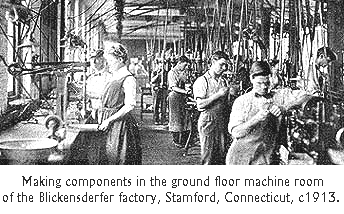 This machine was a
complete break with the Blickensderfer philosophy and a return to the
conventional front-strike 3-bank Qwerty keyboard design. Production of the
Blickensderfer, the Blick 90, and all other manufacturing finally ceased in 1917
with George Blickensderfer’s death. There was no obvious successor to take
over the company and the typewriter business simply died out with him. Lyman Roberts now raised finance
and in 1919 bought out the Blickensderfer patents, machine tools and factory but
only in order to continue manufacturing his own typewriter. In 1922, trading
from the Blickensderfer works, Roberts began production of his machine, renamed
as the Roberts 90, under the banner of the L.R. Roberts Typewriter Co.
Production of the Roberts 90 lasted two years and ended in 1924.
Two years
later, in 1926, wishing to add a low cost machine to the bottom of its portable
range, Remington bought the Blickensderfer tools and dies from the defunct
Roberts Typewriter Company. And in 1927-8, Remington started the production
again of the Blickensderfer 5, now re-named the "Rem-Blick". The
Rem-Blick was only in production for around 9 months, from December 1927 to
about September 1928 (perhaps less) and Richard Polt estimates that only around
6,000 or so machines were made, making surviving machines fairly rare.
This machine was a
complete break with the Blickensderfer philosophy and a return to the
conventional front-strike 3-bank Qwerty keyboard design. Production of the
Blickensderfer, the Blick 90, and all other manufacturing finally ceased in 1917
with George Blickensderfer’s death. There was no obvious successor to take
over the company and the typewriter business simply died out with him. Lyman Roberts now raised finance
and in 1919 bought out the Blickensderfer patents, machine tools and factory but
only in order to continue manufacturing his own typewriter. In 1922, trading
from the Blickensderfer works, Roberts began production of his machine, renamed
as the Roberts 90, under the banner of the L.R. Roberts Typewriter Co.
Production of the Roberts 90 lasted two years and ended in 1924.
Two years
later, in 1926, wishing to add a low cost machine to the bottom of its portable
range, Remington bought the Blickensderfer tools and dies from the defunct
Roberts Typewriter Company. And in 1927-8, Remington started the production
again of the Blickensderfer 5, now re-named the "Rem-Blick". The
Rem-Blick was only in production for around 9 months, from December 1927 to
about September 1928 (perhaps less) and Richard Polt estimates that only around
6,000 or so machines were made, making surviving machines fairly rare. 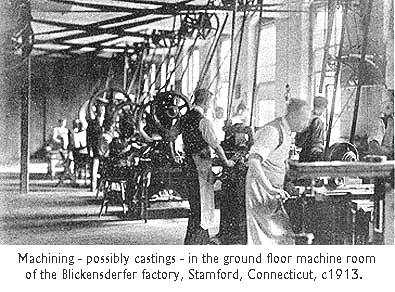 Yet,
curiously, quite a number of variants were produced among this relatively small
output. Some machines were made for export to Germany, with a Qwertz keyboard.
As well as making the Rem-Blick for the domestic US
market, Remington also produced a small number for the British market,
with a Qwerty keyboard and a pound key instead the dollar (see left).
This machine they called the "Baby-Rem". The probable reason
for adopting the slightly odd-sounding title is that just four years
earlier, in 1923, the Austin Motor Company had revolutionised popular
motoring in Britain by launching the low-cost Austin 7 – popularly
known as the "Baby Austin". This car was one of the most
successful British models ever made, selling more than 290,000, making
the term "Baby" a popular catch-phrase term much like
"Mini" in the 1960s. Remington’s marketing department
probably hoped that a "Baby" Remington would be as popular
with typists as the "Baby" Austin was with motorists. Other machines were produced with the variant name
"SP-Blick" (for "Smith Premier Blick"). Most Rem-Blicks had
the standard Remington Qwerty keyboard, but a few machines were produced
featuring Blickensderfer's pet "scientific" keyboard with Dhiatensor
on the bottom row. The Rem-Blick was advertised by Sears in 1929 for $22.50, and
in 1930 under the name "The Blick," for $19.75. The Remington design
team thoroughly "Remingtonised" the Blick wherever possible: they
covered the distinctive sloping wooden case with the same leatherette fabric
used for the Remington Portable case; they changed the keytops for the white
celluloid keys of the Remington, and they gave the platen a thumbwheel from the
Remington Portable.And they designed a new name and gilt decal (transfer) to announce
its new ownership and identity. Yet, curiously, the Remington design engineers
did not change the original Blickensderfer design in any detail. This is curious
because they had a golden opportunity to correct some long standing errors and
omissions. For instance they could have easily added a backspace key, and easily
made the case just an inch longer so that the space bar Yet,
curiously, quite a number of variants were produced among this relatively small
output. Some machines were made for export to Germany, with a Qwertz keyboard.
As well as making the Rem-Blick for the domestic US
market, Remington also produced a small number for the British market,
with a Qwerty keyboard and a pound key instead the dollar (see left).
This machine they called the "Baby-Rem". The probable reason
for adopting the slightly odd-sounding title is that just four years
earlier, in 1923, the Austin Motor Company had revolutionised popular
motoring in Britain by launching the low-cost Austin 7 – popularly
known as the "Baby Austin". This car was one of the most
successful British models ever made, selling more than 290,000, making
the term "Baby" a popular catch-phrase term much like
"Mini" in the 1960s. Remington’s marketing department
probably hoped that a "Baby" Remington would be as popular
with typists as the "Baby" Austin was with motorists. Other machines were produced with the variant name
"SP-Blick" (for "Smith Premier Blick"). Most Rem-Blicks had
the standard Remington Qwerty keyboard, but a few machines were produced
featuring Blickensderfer's pet "scientific" keyboard with Dhiatensor
on the bottom row. The Rem-Blick was advertised by Sears in 1929 for $22.50, and
in 1930 under the name "The Blick," for $19.75. The Remington design
team thoroughly "Remingtonised" the Blick wherever possible: they
covered the distinctive sloping wooden case with the same leatherette fabric
used for the Remington Portable case; they changed the keytops for the white
celluloid keys of the Remington, and they gave the platen a thumbwheel from the
Remington Portable.And they designed a new name and gilt decal (transfer) to announce
its new ownership and identity. Yet, curiously, the Remington design engineers
did not change the original Blickensderfer design in any detail. This is curious
because they had a golden opportunity to correct some long standing errors and
omissions. For instance they could have easily added a backspace key, and easily
made the case just an inch longer so that the space bar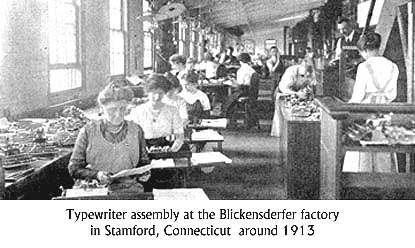 would not have to fold
up and the typewriter could have been used in its case. Perhaps they felt that
to meddle with Blickensderfer’s design was sacrilege – or that the machine
should succeed or fail on its original merits. At any rate, the newly launched
machine appeared to be successfully accomplishing Remington’s aim of filling
the low-cost slot at the bottom of its range, yet after only less than a year,
production was ceased. It may be that the Rem-Blick was dropped to make way for
the new Remington No 3 Portable, which the company made its flagship machine
from December 1928 and which went on after its launch to sell more than 300,000
machines over the next few years. Or it may be that the market had become
sophisticated and no longer wanted an idiosyncratic Victorian design with no
back-space key and no two-colour ribbon. After no less than three encores
following the death of its inventor, the unique Blickensderfer design finally
disappeared for good at the end of 1928 just as the first truly modern would not have to fold
up and the typewriter could have been used in its case. Perhaps they felt that
to meddle with Blickensderfer’s design was sacrilege – or that the machine
should succeed or fail on its original merits. At any rate, the newly launched
machine appeared to be successfully accomplishing Remington’s aim of filling
the low-cost slot at the bottom of its range, yet after only less than a year,
production was ceased. It may be that the Rem-Blick was dropped to make way for
the new Remington No 3 Portable, which the company made its flagship machine
from December 1928 and which went on after its launch to sell more than 300,000
machines over the next few years. Or it may be that the market had become
sophisticated and no longer wanted an idiosyncratic Victorian design with no
back-space key and no two-colour ribbon. After no less than three encores
following the death of its inventor, the unique Blickensderfer design finally
disappeared for good at the end of 1928 just as the first truly modern 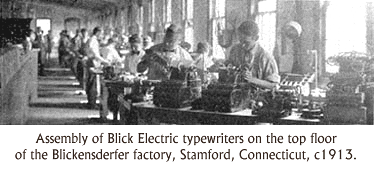 generation of portable typewriters was emerging from the factories of the big
name manufacturers such as Remington,
Underwood, Corona, Imperial and Royal.
generation of portable typewriters was emerging from the factories of the big
name manufacturers such as Remington,
Underwood, Corona, Imperial and Royal.
The Portable Typewriter Website
Copyright © Richard Milton 2003-2004
Photographs by courtesy of The Stamford Museum
|